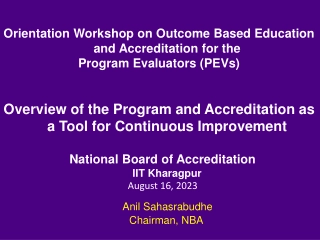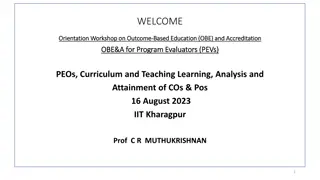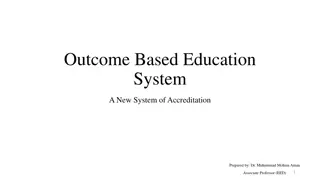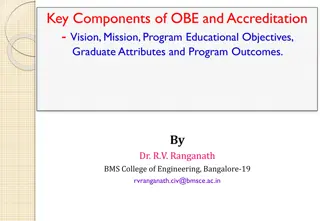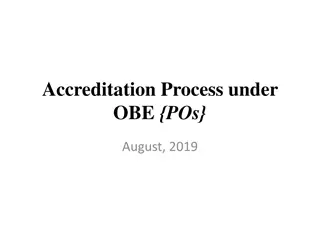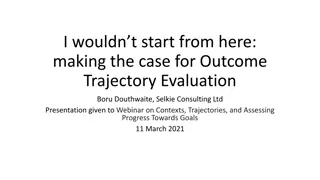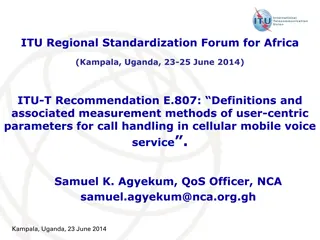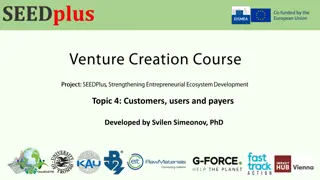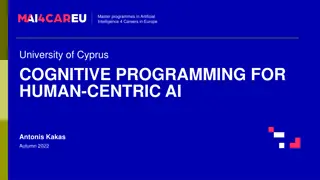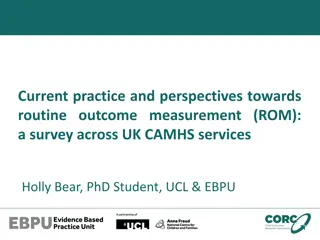Student-Centric Outcome-Based Education
Explore Outcome-Based Education (OBE) by Prof. Urmila Patil, focusing on student-centric teaching and learning methodology with clear objectives and outcomes. Discover how OBE enhances curriculum delivery and assessment.
Download Presentation

Please find below an Image/Link to download the presentation.
The content on the website is provided AS IS for your information and personal use only. It may not be sold, licensed, or shared on other websites without obtaining consent from the author.If you encounter any issues during the download, it is possible that the publisher has removed the file from their server.
You are allowed to download the files provided on this website for personal or commercial use, subject to the condition that they are used lawfully. All files are the property of their respective owners.
The content on the website is provided AS IS for your information and personal use only. It may not be sold, licensed, or shared on other websites without obtaining consent from the author.
E N D
Presentation Transcript
Prof. Urmila Patil Professor (ECE), Former Dean Academics, Former IQAC coordinator, Dr. D. Y. Patil Institute of Technology, Pimpri, Pune 18.
Outcome Based Education Outcome-Based Education (OBE) is a student-centric teaching and learning methodology in which the course delivery, assessment are planned to achieve stated objectives (goals) and outcomes. Starting with a clear picture of what is important for students to be able to do Then organizing the curriculum, delivary and assessment to make sure learning happens Prof. Urmila Patil 25/09/2023 2
Outcome Based Education Prof. Urmila Patil 25/09/2023 3
Objectives (Goals) A VISION is your Institute's goal ..Where you hope to see it in the future. This leads to Vision of the department or program. A Vision statements needs to be proactive, concise and easy to recall. Institute and Department Mission statements show the actions taken to achieve the respective visions. PEOs are consistent with dept. mission and indicate Preparedness of the graduates to attain career and professional accomplishments within a few year( preferably in 3-5 years) of graduation as, Preparation (Employment/Higher studies), Core competence(Discipline knowledge), Breadth (Skills, Research), Professionalism (training/ III),Life long learning (Environment). Prof. Urmila Patil 25/09/2023 4
Dissemination of Vision, Mission and PEOs among stakeholders Vision and Mission statements are displayed at the following prominent places 1. Entrance of the Department 3. Laboratories 5. Department Library Manuals 7. Newsletters and Magazine Student s Diary 9. Departmental website 2. HOD office 4. Notice Boards 6. Course files/ Laboratory 8. Institute website 10. Departmental Brochure(s) Vision and Mission statements are disseminated to all the stakeholders of the programs during meetings (parents meet,alumni meet etc.) and Departmental Presentations,etc. Prof. Urmila Patil 25/09/2023 5
Outcomes Program Outcomes (POs) : describe what students are expected to know and would be able to do by the time of graduation. These relate to the skills, knowledge, and behaviors that students acquire as they progress through the program. Program Specific Outcomes (PSO):PSOs are outcomes that are specific to a program. PSOs characterize the specificity of the core courses of a program. PSOs can be 2 to 4 in number. Course Outcomes (CO): Course Outcomes (COs) are what the student should be able to do at the end of a course.The most important aspect of a CO is that it should be observable and measurable Prof. Urmila Patil 25/09/2023 6
Prof. Urmila Patil 25/09/2023 7
Program Curriculum The courses in the curriculum are defined into the following course components: 1. Basic Courses 2. Core Courses 3. Humanities and Social Sciences courses 4. Management courses 5. Professional courses 6. Subject Elective courses 7. Open Elective courses 8. Project and Seminars Prof. Urmila Patil 25/09/2023 8
Program Curriculum Curriculum- affiliated institutions-Tasks for outcome attainment Analyze the University Curriculum Determine the Gaps in Attainment of POs Design Extra modules or Assessments to Bridge these gaps (Content beyond syllabus) Need a few iterations for their impact on attainment and hence quality of outcomes. Prof. Urmila Patil 25/09/2023 9
Teaching - Learning Processes Academic Calendar Pedagogical initiatives Weak and Bright students Classroom and Lab teaching Continuous Evaluation Quality of student projects Initiative related to outside institute interaction Initiatives related to internship / Training Student feedback of T-L and action taken there of Prof. Urmila Patil 25/09/2023 11
Teaching - Learning Processes Internal Question Papers Internal examination schedule is provided in the academic calendar. Departmental Class test coordinator prepares class test and prelim time table and invigilation duty slot for smooth conduction of examination. Question Paper setting by considering level of blooms taxonomy and map the questions with COs and PSOs. The question paper set by the course teacher is discussed in Cohort cluster to ensure quality of question paper. A sample question paper is to be kept as the documentary evidence. Prof. Urmila Patil 25/09/2023 12
Teaching - Learning Processes Sample question paper Prof. Urmila Patil 25/09/2023 13
Teaching - Learning Processes Prof. Urmila Patil 25/09/2023 14
Teaching - Learning Processes Quality of student projects Allocation Procedure of Project Guide and Topic Types and relevance of the projects and their contribution towards attainment of POs and PSOs Process for monitoring and evaluation XYZ Univ. Guidelines for evaluation of project work Process to assess individual and team performance Quality of completed projects/working prototypes Papers published /Awards received by Projects Prof. Urmila Patil 25/09/2023 15
Teaching - Learning Processes Rubrics for Project evaluation : Weekly meetings with respective guide on the project day as allotted in the timetable and Departmental Project Committee evaluates student group periodically Prof. Urmila Patil 25/09/2023 16
Establish the correlation Cos-POs and COs-PSOs Enter correlation levels 1, 2 or 3 as defined below: 1- Slight (Low) 2- Moderate (Medium) 3- Substantial (High) It there is no correlation,put - . Course PO Name Class 1 2 3 4 5 6 7 8 9 10 11 12 CO C205.1 2 2 2 2 1 2 1 - 1 1 - 2 Electronics Digital C205.2 2 2 2 2 2 2 2 2 1 - 1 2 SE C205.3 1 2 2 2 2 2 1 1 1 - 1 2 C205.4 1 2 2 2 2 2 2 1 - 1 2 2 Course Name Class CO PSO 1 PS0 2 PS0 3 C205.1 3 - - Electronics Digital C205.2 3 - - SE C205.3 3 - 1 C205.4 3 1 1 Prof. Urmila Patil 25/09/2023 17
Establish the correlation between the courses and POs and PSOs Program level Course-PO matrix of all courses INCLUDING first year courses Year Course C101 C102 C103 C104 C105 C106 C107 C108 C109 C110 C111 C112 1 2 3 4 5 6 7 8 9 10 0.00 0.00 2.67 2.00 0.00 0.00 0.00 0.00 0.00 0.00 0.00 0.00 11 0.00 0.00 2.33 1.33 0.00 0.00 0.00 0.00 0.00 0.00 0.00 0.00 12 0.00 0.00 1.67 2.00 0.00 2.00 0.00 0.00 0.00 0.00 1.00 2.00 3.00 2.33 2.33 3.00 3.00 3.00 3.00 1.67 3.00 3.00 2.67 3.00 3.00 2.00 2.33 3.00 2.00 2.50 3.00 2.00 3.00 2.00 2.00 2.00 2.00 0.00 0.00 0.00 0.00 1.00 3.00 1.00 3.00 0.00 1.00 2.00 0.00 0.00 2.33 1.33 0.00 0.00 0.00 0.00 1.33 0.00 0.00 0.00 0.00 0.00 2.67 2.00 0.00 2.00 0.00 0.00 0.00 0.00 1.00 1.50 0.00 2.00 0.00 1.33 0.00 0.00 0.00 2.00 0.00 0.00 0.00 0.00 0.00 0.00 0.00 2.00 2.00 0.00 0.00 2.00 2.67 0.00 0.00 0.00 0.00 0.00 2.00 1.33 0.00 0.00 0.00 0.00 0.00 0.00 0.00 0.00 0.00 0.00 2.67 3.00 1.00 0.00 0.00 0.00 0.00 0.00 1.00 0.00 First Year ---------- Average values of POs 2.54 2.38 1.92 1.63 1.75 1.42 1.29 1.23 1.53 1.45 1.36 1.50 Prof. Urmila Patil 25/09/2023 18
Attainment of Course Outcomes Data collection processes for evaluation of CO attainment may include,but are not limited to, Internal exam or tests/tutorial questions assignments laboratory tests project evaluation student portfolios (A portfolio that demonstrate skills, accomplishments created by the student during study period) is a personal characteristics and collection of artifacts Prof. Urmila Patil 25/09/2023 19
Attainment of Course Outcomes Prof. Urmila Patil 25/09/2023 20
Attainment of Course Outcomes Record the attainment of Course Outcomes of all courses with respect to set attainment levels The attainment levels shall be set considering average performance levels in the university examination or any higher value set as target for the assessment years. Attainment level is to be measured in terms of student performance in internal assessments with respect to the Course Outcomes of a course in addition to the performance in the University examination Prof. Urmila Patil 25/09/2023 21
Attainment of Course Outcomes Where, PP- Theory Paper, TW- Term work, OE- Online Exam, OR Oral, T- No. of Assessment tools Prof. Urmila Patil 25/09/2023 22
Attainment of Course Outcomes Measuring CO attainment through InternalAssessments: Example : Mid-term test 1 addresses C202.1 and C202.2. Out of the maximum 20 marks for this test 12 marks are associated with C202.1 and 8 marks are associated with C202.2. Attainment Level 1:60% students scoring more than 60% marks out of the relevant maximum marks. Attainment Level 2:70% students scoring more than 60% Attainment Level 3:80% students scoring more than 60% Attainment is measured in terms of actual percentage of students getting set percentage of marks. If targets are achieved then the C202.1 and C202.2 are attained for that year. Program is expected to set higher targets for the following years as a part of continuous improvement. If targets are not achieved the program should put in place an action plan to attain the target in subsequent years. Prof. Urmila Patil 25/09/2023 23
3.2 Attainment of Course Outcomes 3.2.2. Record the attainment of Course Outcomes of all courses with respect to set attainment levels (40) Measuring CO attainment through InternalAssessments: Target may be stated in terms of percentage of students getting more than class average marks or set by the program in each of the associated COs in the assessment instruments (midterm tests, assignments, mini projects, reports and presentations etc.as mapped with the COs) Prof. Urmila Patil 25/09/2023 24
Attainment of Course Outcomes Measuring Course Outcomes attained through University Examinations Attainment Level 1: 60% students scoring more than University average percentage marks or set attainment level in the final examination. Attainment Level 2: 70% students Attainment Level 3: 80% students Attainment is measured in terms of actual percentage of students getting set percentage of marks. If targets are achieved then all the COs are attained for that year. Program is expected to set higher targets for the following years as a part of continuous improvement. If targets are not achieved the program should put in place an action plan to attain the target in subsequent years. Prof. Urmila Patil 25/09/2023 25
Attainment of Course Outcomes Attainment through University Examination:Substantial i.e.3 Attainment through InternalAssessment:Moderate i.e.2 Assuming 60% weightage to University examination and 40% weightage to Internal assessment,the attainment calculations will be 60% of 3 + 40% of 2 = 1.8 + 0.8 = 2.6 Prof. Urmila Patil 25/09/2023 26
Prof. Urmila Patil 25/09/2023 27
Attainment of POs and PSOs Prof. Urmila Patil 25/09/2023 28
Attainment of POs and PSOs Provide results of evaluation of each PO & PSO Example: 1. It is assumed that a particular PO has been mapped to four courses C2O1,C3O2,C3O3 and C4O1 2.The attainment level for each of the four courses will be as given in 3,2,2 3. PO attainment level will be based on attainment levels of direct assessment and indirect assessment 4. For affiliated, non-autonomous colleges, for overall attainment level 80% weightage may be given to direct assessment and 20% weightage to indirect assessment through surveys from students(largely), employers (to some extent). Program may have different weightages with appropriate justification. Prof. Urmila Patil 25/09/2023 29
Attainment of POs and PSOs Example contd.. Direct Assessment: C201 High (3) ; C302 Medium (2) ; C303 Low (1) ;C401 High (3) Attainment level will be summation of levels divided by no. of courses 3+2+1+3/4= 9/4=2.25 Indirect Assessment Surveys, Analysis, customized to an average value as per levels 1, 2 & 3. Assumed level - 2 6. PO Attainment level will be 80% of direct assessment + 20% of indirect assessment i.e. 1.8 + 0.4 = 2.2. Note: Similarly for PSOs. Prof. Urmila Patil 25/09/2023 30
Thank You.. Thank You.. Prof. Urmila Patil 25/09/2023 31
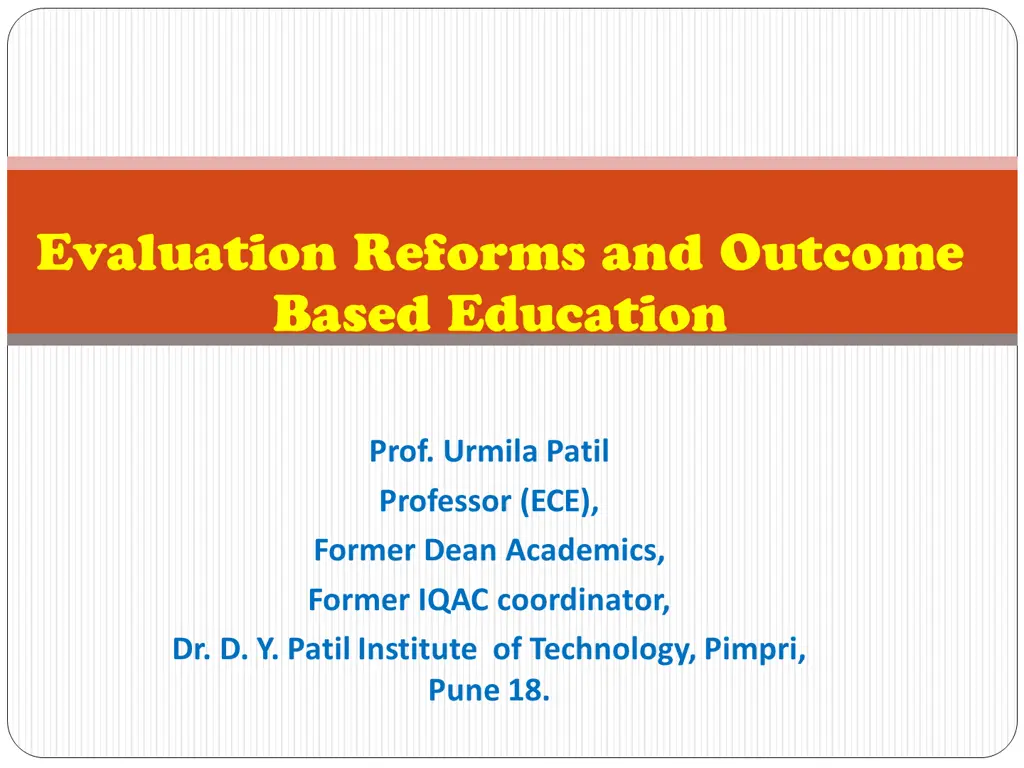
 undefined
undefined









